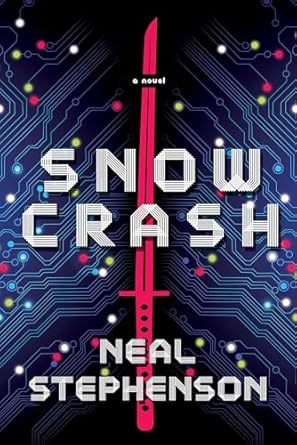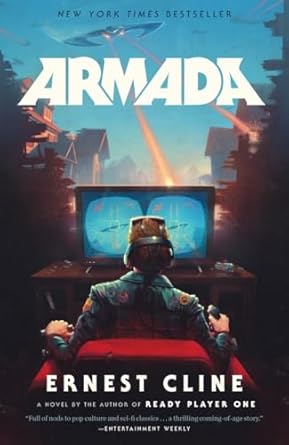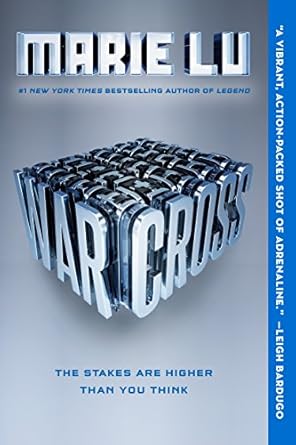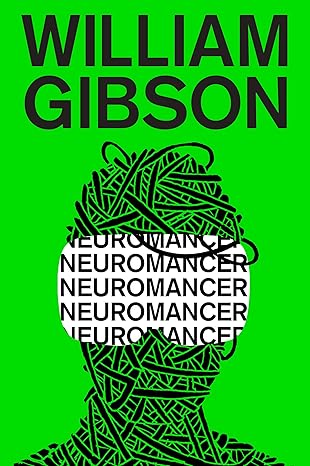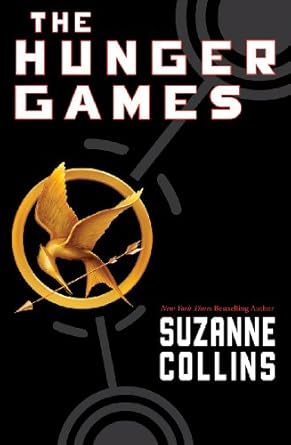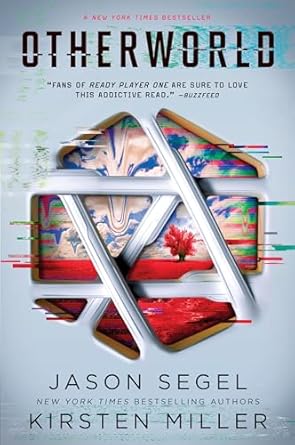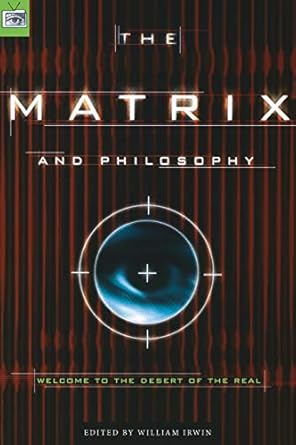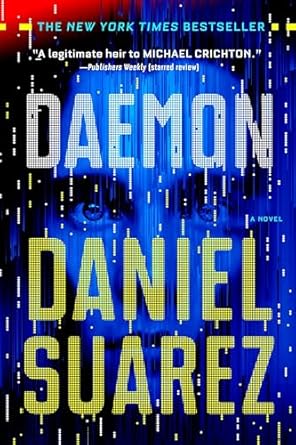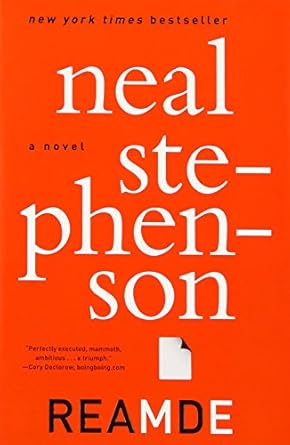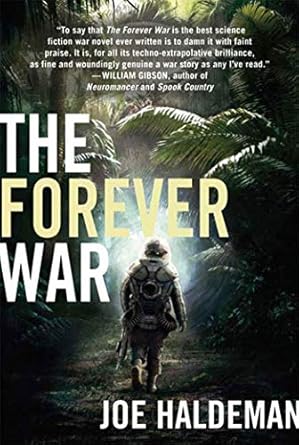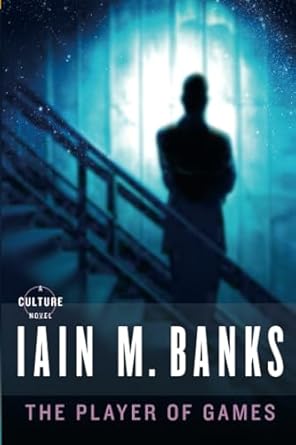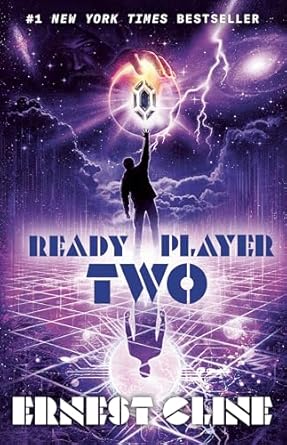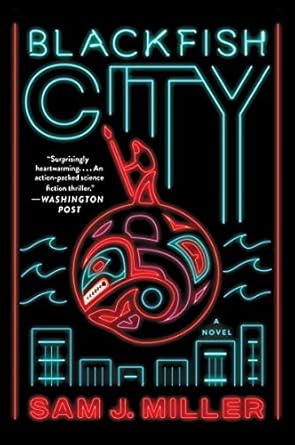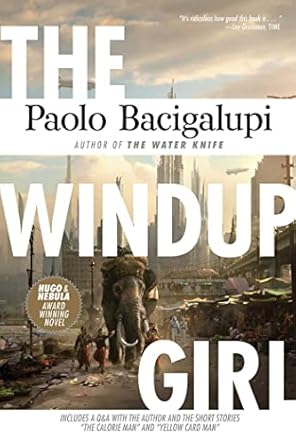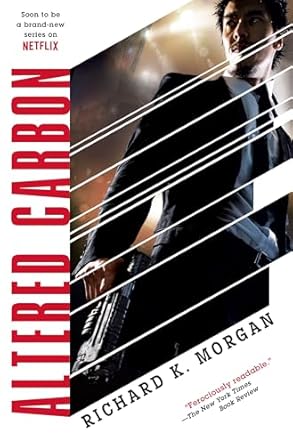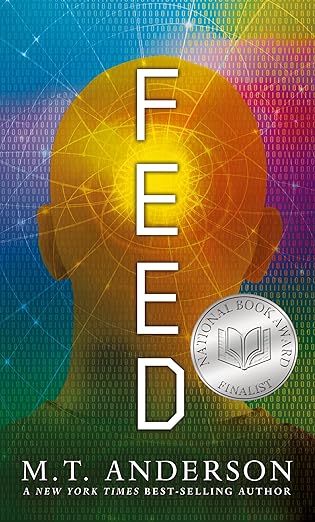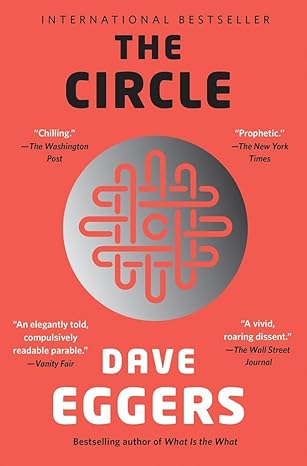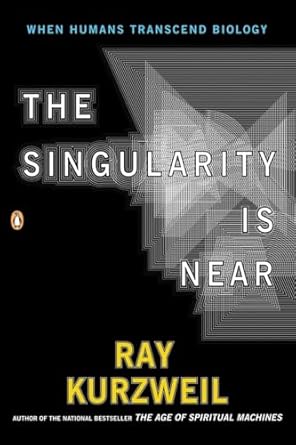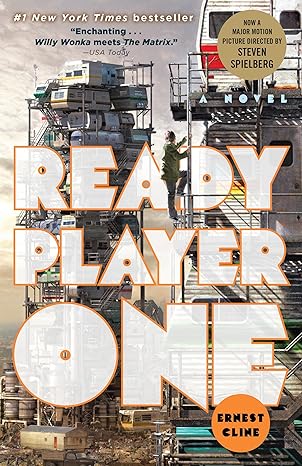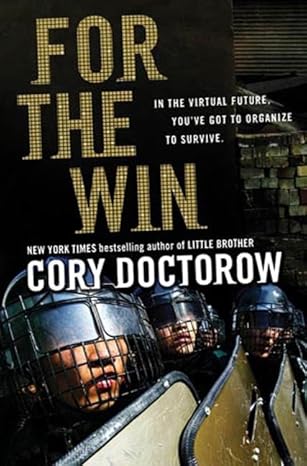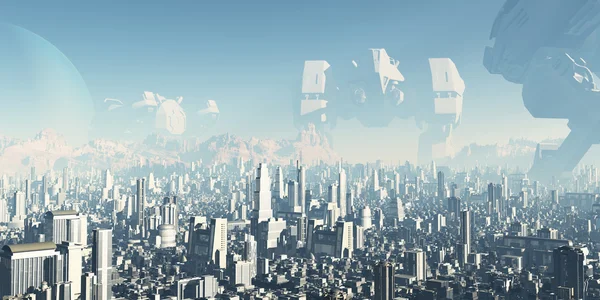Summary: In today's article, I've compiled 20 of the best books similar to Ready Player One that dive into futuristic worlds, virtual realities, and tech-driven adventures. Here are my top 3:
- Snow Crash by Neal Stephenson
- Armada by Ernest Cline
- Warcross by Marie Lu
If you loved Ready Player One, you’ll enjoy books set in futuristic worlds full of technology, virtual realities, and gaming. These stories explore themes like escaping into digital landscapes, the power of tech, and its impact on society, all while mixing adventure, mystery, and dystopia. Packed with thrilling quests, nostalgic references, and high-stakes action, they’re perfect for anyone who craves fast-paced reads with thought-provoking ideas and mind-bending twists.
TOP 20: Best Books Similar to Ready Player One
- Snow Crash by Neal Stephenson
- Armada by Ernest Cline
- Warcross by Marie Lu
- Neuromancer by William Gibson
- The Hunger Games by Suzanne Collins
- Otherworld by Jason Segel and Kirsten Miller
- The Matrix and Philosophy: Welcome to the Desert of the Real by William Irwin
- Daemon by Daniel Suarez
- Reamde by Neal Stephenson
- The Forever War by Joe Haldeman
- The Player of Games by Iain M. Banks
- Ready Player Two by Ernest Cline
- Blackfish City by Sam J. Miller
- The Windup Girl by Paolo Bacigalupi
- Altered Carbon by Richard K. Morgan
- Feed by M.T. Anderson
- The Circle by Dave Eggers
- The Singularity is Near by Ray Kurzweil
- Ready Player One: The Graphic Novel by Ernest Cline and Zac Gorman
- For the Win by Cory Doctorow
1. Snow Crash
- Author: Neal Stephenson
- About: A fast-paced cyberpunk novel set in a future America, where a computer virus called “Snow Crash” threatens both the digital and physical worlds.
- Style of writing: Descriptive, witty, and filled with technological jargon.
- Length: Approximately 440 pages (around 110,000 words)
- Year written: 1992
- Emotional impact: High energy, with a mix of action and philosophical ideas that stick with readers.
- Difficulty level: Medium to high, due to the heavy use of technical concepts and cultural references.
- Why read it: It's a classic of the cyberpunk genre and deeply influential to the Ready Player One universe.
2. Armada
- Author: Ernest Cline
- About: A young man discovers that a popular video game is actually a training simulation for an impending alien invasion, and he is recruited to save the world.
- Style of writing: Nostalgic, humorous, and fast-paced.
- Length: Approximately 368 pages (around 90,000 words)
- Year written: 2015
- Emotional impact: Entertaining and fun, but less emotionally intense than Ready Player One.
- Difficulty level: Easy to medium, with clear writing and lots of pop-culture references.
- Why read it: If you enjoyed Ready Player One, this offers a similar nostalgic and gaming-centered adventure.
3. Warcross
- Author: Marie Lu
- About: Set in a future where a virtual reality game, Warcross, is more than just entertainment—it’s a cultural phenomenon. A hacker gets involved in a dangerous conspiracy surrounding the game.
- Style of writing: Fast-paced, engaging, and emotionally driven.
- Length: Approximately 368 pages (around 90,000 words)
- Year written: 2017
- Emotional impact: High emotional stakes with romance, action, and social commentary.
- Difficulty level: Medium, with straightforward writing and some technical elements.
- Why read it: A gripping blend of virtual reality, hacking, and high-stakes gaming in a beautifully crafted world.
4. Neuromancer
- Author: William Gibson
- About: The groundbreaking novel that defined the cyberpunk genre, following a washed-up computer hacker who gets pulled into a world of artificial intelligence and virtual reality.
- Style of writing: Complex, poetic, and heavily technical.
- Length: Approximately 271 pages (around 70,000 words)
- Year written: 1984
- Emotional impact: Intellectual and thought-provoking, with a lasting influence on the genre.
- Difficulty level: High, due to dense, abstract writing and technical concepts.
- Why read it: It's a seminal work in cyberpunk and directly inspired many elements of Ready Player One.
5. The Hunger Games
- Author: Suzanne Collins
- About: Set in a dystopian future, the story follows a young girl forced to participate in a televised battle to the death, all while struggling against a brutal, oppressive regime.
- Style of writing: Straightforward, fast-paced, and accessible.
- Length: Approximately 374 pages (around 90,000 words)
- Year written: 2008
- Emotional impact: Powerful, emotional, and leaves readers reflecting on themes of survival, power, and resistance.
- Difficulty level: Medium, with accessible language but heavy themes.
- Why read it: It's a gripping, emotional story set in a dystopian world, perfect for fans of high-stakes, survival-themed fiction.
6. Otherworld
- Author: Jason Segel and Kirsten Miller
- About: A teenager enters a game world that blurs the line between reality and fantasy, but he soon discovers the dark forces behind it.
- Style of writing: Engaging, with a mix of humor and suspense.
- Length: Approximately 464 pages (around 110,000 words)
- Year written: 2017
- Emotional impact: Thrilling with a strong sense of mystery and intrigue.
- Difficulty level: Medium, accessible with some tech-related elements.
- Why read it: It explores themes of virtual reality and gaming with a thrilling plot and intriguing twists.
7. The Matrix and Philosophy: Welcome to the Desert of the Real
- Author: William Irwin
- About: A philosophical exploration of The Matrix, examining its deeper meanings and connections to real-world issues like reality, freedom, and technology.
- Style of writing: Academic, thought-provoking, and deeply analytical.
- Length: Approximately 256 pages (around 70,000 words)
- Year written: 2002
- Emotional impact: Intellectual stimulation; less emotional than narrative fiction.
- Difficulty level: High, due to philosophical concepts and academic language.
- Why read it: Perfect for readers who want to dig deeper into the themes behind virtual reality and the nature of existence, as seen in Ready Player One and The Matrix.
8. Daemon
- Author: Daniel Suarez
- About: A thriller about a rogue AI system (Daemon) that starts controlling global events, creating chaos in the real world through the virtual one.
- Style of writing: Fast-paced, technical, and suspenseful.
- Length: Approximately 512 pages (around 130,000 words)
- Year written: 2006
- Emotional impact: Intense, with a focus on tension and conspiracy.
- Difficulty level: Medium to high, with technical jargon about hacking and AI.
- Why read it: A fascinating take on AI, virtual worlds, and their real-world consequences, appealing to fans of high-tech thrillers.
9. Reamde
- Author: Neal Stephenson
- About: A thriller set around a massively multiplayer online role-playing game (MMORPG) that becomes a battleground for terrorists, hackers, and players.
- Style of writing: Complex, detailed, and action-packed.
- Length: Approximately 1,050 pages (around 270,000 words)
- Year written: 2011
- Emotional impact: Highly engaging with moments of intense action and psychological drama.
- Difficulty level: High, due to its length and dense content.
- Why read it: A fast-paced, tech-heavy thriller that tackles both online gaming and real-world action.
10. The Forever War
- Author: Joe Haldeman
- About: A soldier's experience in an interstellar war, where time dilation causes him to age at a different rate from those he left behind.
- Style of writing: Thoughtful, philosophical, and focused on character development.
- Length: Approximately 276 pages (around 70,000 words)
- Year written: 1974
- Emotional impact: Reflective and emotional, dealing with themes of war, time, and alienation.
- Difficulty level: Medium, with a focus on narrative and emotional depth.
- Why read it: A science fiction classic with deep psychological and social insights.
11. The Player of Games
- Author: Iain M. Banks
- About: A story about a master game player who is recruited by an advanced alien civilization to play a game that might have galaxy-changing consequences.
- Style of writing: Philosophical, with detailed world-building and intricate plotting.
- Length: Approximately 480 pages (around 120,000 words)
- Year written: 1988
- Emotional impact: Intellectual and emotional, focusing on power, games, and human nature.
- Difficulty level: Medium, with philosophical themes.
- Why read it: A compelling mix of high-stakes gaming and deep philosophical exploration.
12. Ready Player Two
- Author: Ernest Cline
- About: The sequel to Ready Player One, following Wade Watts as he embarks on a new quest within the OASIS, uncovering more about the game's origins.
- Style of writing: Nostalgic, fast-paced, and humorous.
- Length: Approximately 384 pages (around 95,000 words)
- Year written: 2020
- Emotional impact: Less impactful than the first, but still engaging and nostalgic.
- Difficulty level: Easy, with clear writing and pop culture references.
- Why read it: A fun continuation for fans of Ready Player One with more adventure and gaming thrills.
13. Blackfish City
- Author: Sam J. Miller
- About: A dystopian science fiction novel set on a floating city, where a young girl uncovers mysteries linked to her family's tragic past.
- Style of writing: Rich in world-building with a poetic tone.
- Length: Approximately 368 pages (around 95,000 words)
- Year written: 2018
- Emotional impact: Emotional depth with themes of survival, identity, and social justice.
- Difficulty level: Medium, with complex world-building and themes.
- Why read it: For fans of intricate, character-driven sci-fi with strong social themes.
14. The Windup Girl
- Author: Paolo Bacigalupi
- About: A post-apocalyptic science fiction novel set in a future where biotechnology is central to society, and the world is in ecological and economic collapse.
- Style of writing: Dark, atmospheric, and detailed world-building.
- Length: Approximately 512 pages (around 125,000 words)
- Year written: 2009
- Emotional impact: Heavy emotional weight, exploring themes of survival and human greed.
- Difficulty level: High, due to its complex world-building and heavy themes.
- Why read it: For those interested in dystopian worlds and the consequences of bioengineering.
15. Altered Carbon
- Author: Richard K. Morgan
- About: In a future where consciousness can be transferred between bodies, a former soldier is hired to investigate the apparent suicide of a wealthy businessman.
- Style of writing: Hard-boiled detective style mixed with sci-fi elements.
- Length: Approximately 544 pages (around 130,000 words)
- Year written: 2002
- Emotional impact: Explores deep themes of identity, morality, and death.
- Difficulty level: Medium to high, with philosophical undertones and futuristic jargon.
- Why read it: A gritty, action-packed noir thriller with philosophical musings about immortality and technology.
16. Feed
- Author: M.T. Anderson
- About: A dystopian novel set in a future where people have computer feeds implanted in their brains, influencing their thoughts, desires, and behaviors.
- Style of writing: Satirical and darkly comedic.
- Length: Approximately 299 pages (around 75,000 words)
- Year written: 2002
- Emotional impact: Thought-provoking and chilling, focusing on consumerism and loss of autonomy.
- Difficulty level: Medium, with accessible writing but intense social commentary.
- Why read it: A biting critique of modern technology, consumerism, and social media.
17. The Circle
- Author: Dave Eggers
- About: A young woman joins a powerful tech company, The Circle, which has a seemingly utopian culture, but it soon becomes clear that the company has far-reaching and dark motives.
- Style of writing: Engaging, with a sense of creeping dread.
- Length: Approximately 532 pages (around 130,000 words)
- Year written: 2013
- Emotional impact: Disturbing and thought-provoking, exploring the dangers of surveillance and privacy loss.
- Difficulty level: Medium, with accessible language and accessible, yet complex, themes.
- Why read it: For a chilling look at the potential consequences of unchecked corporate control over technology.
18. The Singularity is Near
- Author: Ray Kurzweil
- About: A non-fiction book that discusses the future of technology, particularly the concept of the singularity—the moment when artificial intelligence surpasses human intelligence.
- Style of writing: Analytical, scientific, and speculative.
- Length: Approximately 652 pages (around 160,000 words)
- Year written: 2005
- Emotional impact: More intellectual than emotional, provoking deep thought about future technological advances.
- Difficulty level: High, as it covers complex scientific concepts and predictions.
- Why read it: If you're interested in the future of AI and the intersection of technology with humanity, this book offers a deep dive into those topics.
19. Ready Player One: The Graphic Novel
- Author: Ernest Cline and Zac Gorman
- About: The graphic novel adaptation of Ready Player One, illustrating the original story with vibrant artwork.
- Style of writing: Visual storytelling with dialogue from the original book.
- Length: Approximately 224 pages (around 50,000 words)
- Year written: 2018
- Emotional impact: A visual retelling that evokes nostalgia and excitement.
- Difficulty level: Easy, as it's a graphic novel with a focus on visuals over text.
- Why read it: For fans of the original Ready Player One, it's a great way to revisit the world in a fresh and artistic format.
20. For the Win
- Author: Cory Doctorow
- About: A novel about the world of online gaming, exploring labor exploitation within virtual economies and the fight for workers’ rights in a digital space.
- Style of writing: Fast-paced, with a strong focus on social commentary and activism.
- Length: Approximately 560 pages (around 140,000 words)
- Year written: 2010
- Emotional impact: Thought-provoking, especially for readers interested in digital labor and gaming culture.
- Difficulty level: Medium, with clear writing but complex themes around economics and activism.
- Why read it: A great mix of gaming, economics, and activism, it’s perfect for those who want a deeper look at the intersection of technology and society.
Conclusion
In conclusion, if you loved Ready Player One, I think you’ll really enjoy these top three picks—Snow Crash, Armada, and Warcross. Each one offers a unique spin on virtual realities, futuristic tech, and high-stakes adventures, all with a mix of gaming, mystery, and dystopian themes. Whether you're exploring a digital universe, battling aliens, or diving into a game that could change everything, I’m confident these books will keep you hooked and deliver the same exciting, tech-driven thrills you loved in Ready Player One.

